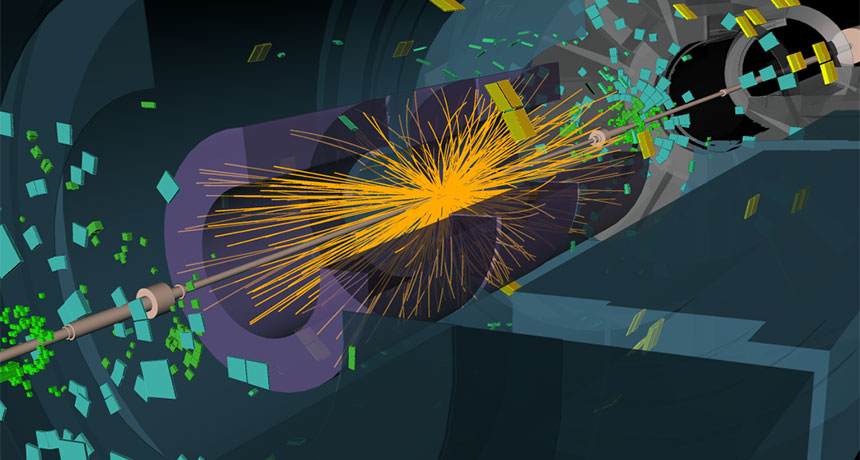Cern’s Portal To Another Dimension & Other Unbelievable Facts
The LHC is the largest machine in the world. It took thousands of scientists, engineers and technicians decades to plan and build, and it continues to operate at the very boundaries of scientific knowledge.

The LHC is a particle accelerator that pushes protons or ions to near the speed of light. It consists of a 27-kilometre ring of superconducting magnets with a number of accelerating structures that boost the energy of the particles along the way.
The Large Hadron Collider (LHC) is the most powerful particle accelerator ever built. The accelerator sits in a tunnel 100 meters underground at CERN, the European Organization for Nuclear Research, on the Franco-Swiss border near Geneva, Switzerland.
Let’s get to know 10 unbelievable facts about the CERN
1.The Superconducting Cables Of The LHC Can Wrap The Earth Along The Equator For Almost 7 Times

The combined strands of the superconducting cable being produced for the LHC would go around the equator 6.8 times. If you added all the filaments of the strands together they would stretch to the sun and back 5 times with enough left over for a few trips to the moon.
2. A Weasel And A Bird Caused Blackouts At The World’s Biggest Machine, Twice!

Yes, weasels. In April 2016, the Large Hadron Collider lost power after a nefarious rodent chewed through electrical wiring. This followed an unfortunate incident in 2009, when a bird dropped a bit of baguette onto electrical equipment and caused a power outage. The mightiest human accomplishments can face the most mundane challenges.
3. A Proton Beam In The LHC Has Energy Equivalent To A Car Speeding At 1700 KPH

When protons arrive in the LHC they are travelling at 0.999997828 times the speed of light. Each proton goes around the 27km ring over 11 000 times a second.
A nominal proton beam in the LHC will have an energy equivalent to a person in a Subaru driving at 1700 kph.
4. A Statue Of Hindu God Shiva The Destroyer Stands In Front Of The CERN Headquarters Building

Although most corporations shun any connection with religion and the spiritual world, CERN has chosen as its mascot a Hindu god. But not just any Hindu god. Just outside of its headquarters building sits an ancient statue of Shiva, ancient Apollyon, the god of destruction. Strange?
5. Strange Pictures Resembling A Portal/Door To Another Dimension Surfaced In 2016, As It Was Claimed By CERN’s Former Director

One year after CERN’s grand opening, Sergio Bertolucci, former Director for Research and Scientific Computing of the facility, grabbed headlines when he told a British tabloid the super collider could open otherworldly doors to another dimension for "a very tiny lapse of time,” mere fractions of a second. However, that may be just enough time “to peer into this open door, either by getting something out of it or sending something into it.”
Source = "VARBAGE"
"Of course," added Bertolucci, "after this tiny moment the door would again shut; bringing us back to our 'normal' four-dimensional world ... It would be a major leap in our vision of nature… And of course [there would be] no risk to the stability of our world."
6. LHC Generates 100,000 More Powerful Gravitational Pull Than That Of Earth

The CERN collider is composed of some 9,600 super magnets – which are 100,000 times more powerful than the gravitational pull of Earth - that fire protons around a circular track at mind boggling speeds.
7. According To Stephen Hawking The God Particle Could Destroy Our Universe As We Know It

“The God particle found by CERN could destroy the universe,”
Hawking wrote in the preface to a book, Starmus, a collection of lectures by scientists. The Higgs Boson could become unstable at very high energy levels and have the potential to trigger a
“catastrophic vacuum decay which would cause space and time to collapse and… we would not have any warning to the dangers,” he continued.
Astrophysicist Neil de Grasse Tyson told Eugene Mirman on his Star Talk radio program that the experiment could literally cause the planet to “explode.”
“Ask yourself: How much energy is keeping it together? Then you put more than that amount of energy into the object.” Tyson was confident of the result: “It will explode.”
8.Tim Berners-Lee Founded The World Wide Web At CERN

Nobody knows where fundamental research will lead. Famously, Tim Berners-Lee invented the World Wide Web in 1989 at CERN, as a tool to allow scientists around the world to share data.
9.The Large Hadron Collider Is Colder Than Outer Space

To be precise, it’s 1.9 K (-271.3°C), almost absolute zero. A cryogenic cooling system keeps it this frigid for the sake of the superconductor electromagnets, which send proton beams hurtling towards one another in a loop 100 metres below the ground.
10. The Higgs Boson Isn’t A Particle, It’s The Excitation Of The Higgs Field
Source = "TED-Ed"
The Higgs Boson is unlikely to prove or disprove the existence of God, but it does help to cement the Standard Model: a physics theory developed in the 60s, which outlines the building blocks of matter and the forces that govern them.
Popular Posts
What Is Trypophobia – A Disgust More Than Fear
"I can't really face small, irregularly or asymmetrically placed holes, they make me like, throw up in my mouth, cry a little bi...
Chandan Roy
16 Interesting Facts About Ambidextrous People
A lefty or left-handed uses his left hand more naturally and dominantly than the right hand. And the righty or right-handed is o...
Ethan Stephans
20 Interesting Facts About Meteoroid, Meteor and Meteorite
Watching celestial objects is a true delight. It is still fun to catch a sight of shooting stars when we grow up. A second of th...
Swati Bhandari








